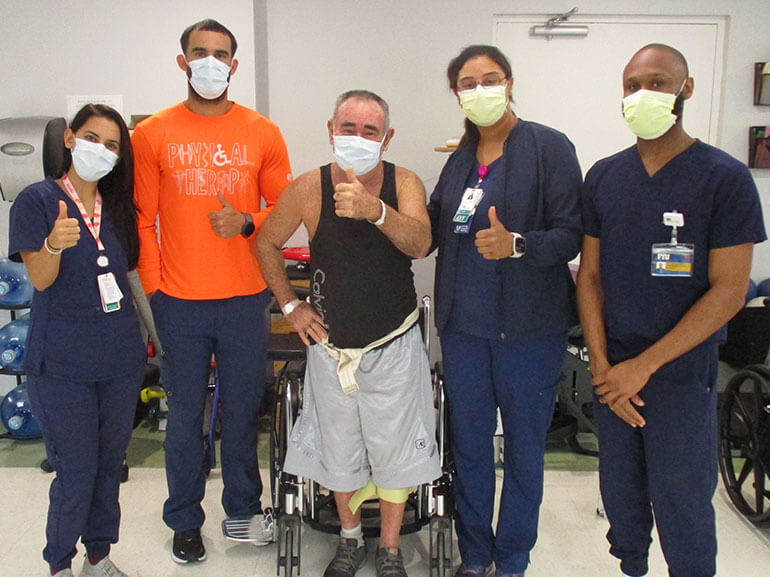Lorenzo's Story

Lorenzo Estepe was proud of his independent streak. After all, he immigrated to the United States from Cuba to create a better life for himself. While his daughters remain in Cuba, he quickly settled in with friends and family in Miami, providing for himself with full-time work at a fencing company.
Following a typical day of hard work, the 62-year-old was looking forward to relaxing at home with a nice dinner. But once Lorenzo parked his car in the driveway, he knew something was off. He couldn’t feel or move his left arm and leg. His roommate jumped into action, helping Lorenzo into the house; but he was unable to shake it off. They called an ambulance.
Doctors at Palmetto hospital administered tests that revealed a bleed on the right side of Lorenzo’s brain. Surgery helped stem the brain bleed and Lorenzo remained in the hospital for the next month to recover and stabilize.
Still unable to walk or move his left leg or his left arm, Lorenzo was facing a long recovery. He selected West Gables Rehabilitation Hospital to begin his journey. Soon after arriving, he met his therapy team - physical, occupational and speech - to set goals for his recovery.
Physical therapy worked on increasing Lorenzo’s strength and coordination on his left side. Therapists used the LiteGait—a device that blends a treadmill and body harness to support a patient’s body weight while they relearn to walk with the proper gait and balance. Lorenzo used the device daily to help him to advance his left leg while walking. Initially he needed maximal assistance to take just a few steps as he retrained his mind and body to move in sequence. But soon, he gained strength and was able to sustain his balance. With that, he moved onto a simpler harness, a supportive waist belt that provided support in walking around a marked track.
Meanwhile, occupational therapy had Lorenzo transferring from the bed to a wheelchair and working on his fine motor skills with activities like brushing his teeth and getting dressed. As coordination came back to his left hand, Lorenzo’s therapy sessions moved to a simulated home environment where he practiced typical independent daily living activities like reaching for utensils at the kitchen counter, organizing them into a drawer and picking up objects from the floor. As he mastered those skills, he evolved to more complex tasks for improving his balance—albeit tasks that were pure enjoyment for Lorenzo—listening to music and dancing.
Advancing motivated Lorenzo who soon embraced other therapeutic exercises—dead lifts, lunges, sit to stands, marches and even single leg stances. As he gained strength and coordination in his left leg, Lorenzo started using an ankle foot orthosis (AFO) which is a plastic brace used to support his left foot as he walked. Lorenzo was also introduced to the Bioness Integrated Therapy System (BITS), technology that allows patients to engage in games and complete tasks to improve dexterity and response time. After three hours of daily therapy, Lorenzo would often retire to his room and continue with independent exercises because he was so motivated to regain his independence.
Prior to his hospitalization, Lorenzo enjoyed a variety of interests from horticulture to caring for farm animals. He hosted his friends for barbecues at his home and frequently went on fishing trips. He focused on returning to activities that brought him joy. His team introduced him to recreational therapy to keep his spirits high and teach him how to safely continue his hobbies. Lorenzo took ownership of caring for the plants in the hospital’s garden, planting new seeds and tending to them daily.
Lorenzo’s speech therapists provided him with important stroke information about how stroke impacts the body—swallowing, cognition, communication, bowel and bladder function—as well as educating him on safety and health awareness from home modifications to hydration and nutrition. The training answered many questions for Lorenzo and prepared him for potential future needs.
After 10 weeks, Lorenzo met all of his goals; he was able to take of his self-care needs and walk with just the assistance of a four-pointed cane for additional stability.
Lorenzo has set new goals – driving and returning to work. While he works on those objectives, Lorenzo is looking forward to spending time with family and friends. He credits his success to the core care team and the dedication of every staff member at West Gables Rehabilitation Hospital who helped him regain his independence. His advice to others on a recovery journey: “Continue to push forward in times of doubt, and look to others for motivation when you need it.”